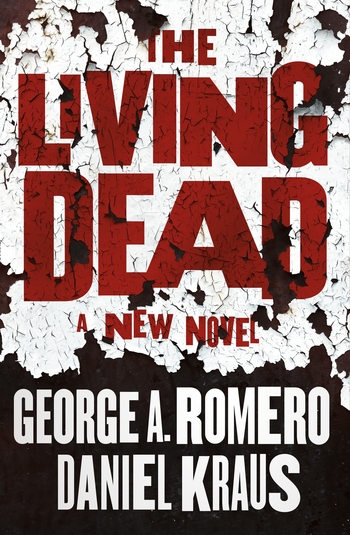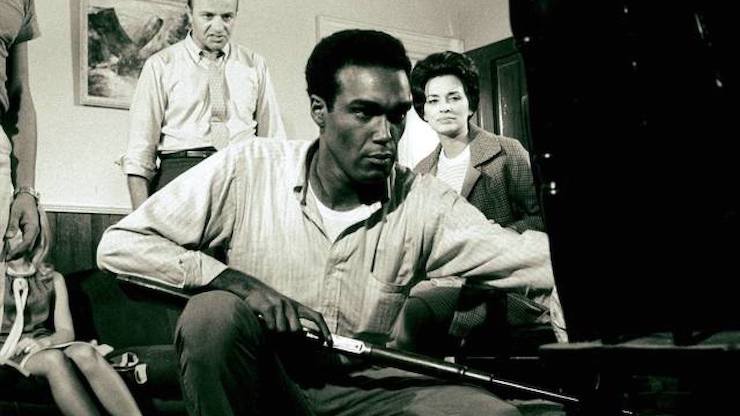George A. Romero’s impact on the horror genre cannot be overstated – his Living Dead films spawned a new and revolutionary subgenre, and you’d be hard pressed to find a horror movie that isn’t in some way in conversation with his work in the decades since. When Romero, the Godfather of the Dead, passed away in 2017, he left behind a tremendous legacy – and also an unfinished draft of an epic novel, an expansion of his cinematic universe that told of the rise of the zombies and the fall of humanity in a way that wasn’t constrained by film budgets and effects work.
And then Suzanne Desrocher-Romero, his widow, chose a successor: Daniel Kraus, coauthor (with Guillermo del Toro) of the New York Times bestselling novel The Shape of Water, and author of The Death and Life of Zebulon Finch. Desrocher-Romero asked Kraus to complete her late husband’s manuscript.
The resulting tome, The Living Dead, is on shelves today – it’s eerily prescient in the way Romero’s work has always been, wide-ranging, poignant, and scary. It’s a must for any zombie fan.
Today we’re thrilled to share part of Daniel Kraus’ author’s note from the book, about what Romero, and Night of the Living Dead, have meant to him.
Plus: down the page, view the ten minute version of Night of the Living Dead made by Kraus and his friends as teenagers. As he puts it: “It’s terrible, of course, but is amusing proof of my Romero obsession.”
When I heard about George’s death, I was visiting family in Virginia. The news came across my gadget, something George would have hated. I had to sit down. All I said, I think, was, “Oh no.” When I was asked what was wrong, I said, “George Romero died.” My sisters and father had sketchy ideas of the significance of this, but my wife, Amanda, understood right away. To say I grew up with George Romero is fanciful but true. The first film I actually recall watching is Night of the Living Dead. I must have been five or six. I saw it with my mom, Susan Laura Kraus, who had a penchant for fright flicks. It may sound like bad parenting, but was, in fact, the best parenting. As Night obsessives know, one of the film’s magical feats is how well it plays to different audiences. (How many films boast a stately Criterion Edition as well as two different RiffTrax versions?) Probably to ward off heebie-jeebies, my mom liked to laugh along to it, razzing the hapless Barbra and booing the cowardly Harry. Crazy though it seems, given the film’s plot, Night of the Living Dead became a safe space for me.
It helped that the movie was always on. Skip this paragraph if this stuff is old hat. When the Walter Reade Organization, the film’s original distributor, changed the title from Night of the Flesh Eaters, it neglected to put the copyright bug on the title screen. That was all it took for Night to plop into the public domain. For George, this was both bad and good. The bad: he’d never make the millions he deserved. The good: because it required no rights payments to screen—and because it was really damn good—it was shown everywhere. If someone in a movie is watching a movie, odds are it’s Night, and my educated guess is that no movie in history has been released on VHS and DVD more often—many hundreds of times.
By every logical measure, the colorized version put out by Hal Roach Studios in 1986 is an atrocity. But let’s get illogical. If you can find a VCR, watching the colorized VHS is the closest you can get to feeling how beat-up and put-upon the film had become. The “colors” are thin and sickly, like tattered flags, yet a nobility lurks in that analog sludge. It’s accidentally beautiful in the way of tenth-generation tapes traded by pre-internet movie buffs. Their ugliness proved how beloved they were, how hard people were willing to work to see them anew.
It’s another of Night’s magical feats. The film was like the zombies it invented: overused and abused, but unwilling to die.

Apple | Bookshop.org | Amazon | Barnes & Noble | IndieBound
Night barely feels like a movie to me. It’s more like an album I love; it’s part of my waking thoughts, my blood and oxygen. Hearing of George’s death reminded me, yet again, how much his stories felt like family stories, how much he felt like family. I engage in little fandom. My home is nearly devoid of media mementos. The one exception is George. The Night poster behind my writing desk. The weird piece of Creepshow fan art I bought the day George died. I keep three framed photos in my office: one of my wife and me, one of my mom, and one of George and me from the only time we ever met: March 6, 2006.
In January 2006, I read an article about George, probably about 2005’s Land of the Dead, in which George’s manager, Chris Roe, was thanked. This can’t be the same Chris Roe from my hometown, I thought. The idea was preposterous. I grew up in the hamlet of Fairfield, Iowa, not exactly a hotbed of Hollywood talent. But my memory of Chris was that he’d been interested in genre film and television. I scoured the internet for an email, wrote him, and days later, we caught up on the phone.
Chris had indeed become a successful talent manager, and one of his clients was George Romero. I told Chris what a fan I was, and he suggested the three of us get together the next time he was near Chicago, where I lived.
Three months later in Rosemont, Illinois, at Fangoria’s Weekend of Horrors, I met Chris in his hotel room, and soon after, George lumbered in from the adjoining room. He looked like George Romero, all right: roughly seventy stories tall, shrunk down to size only by his trademark oversized glasses. He wore his usual green vest, his hair in its usual white ponytail.
He also looked like shit. He was sick. Sick enough, in fact, that he should have canceled the appearance. But he refused to; he took his fans seriously. Eleven years later, his wife, Suzanne Desrocher-Romero, would show me a notebook in which George practiced his signature prior to signing events so it would look all right despite his trembling hands. Regarding the kind of person George Romero was, there is no more poignant piece of evidence.
The three of us had a nice chat, or as nice a chat you can have when the man of the hour can barely stand. George was interested in hearing about my novels, though he was more interested in the small-town history Chris and I shared. Soon, it was time for George’s event. Chris and I escorted him down the elevator and through the halls, serving as guards to keep signature hounds at bay. We stopped only once for George to buy cigarettes. It’s a painful detail. Eleven years later, he would die of lung cancer.
That was it for eleven years. A month after George died, I received a call from Chris. We’d stayed in loose touch over the preceding decade, during which both our careers developed. By then, I was hard at work on my second collaboration with Guillermo del Toro, The Shape of Water. I was delighted to hear from Chris, but fully unprepared for the new kind of collaboration he proposed: completing the epic zombie novel George had left unfinished.
There were more obvious choices. Authors more famous, authors known for zombie fiction. I’d circled the topic before, if obliquely. My Zebulon Finch duology features an undead protagonist, though he’s agile and debonair, about as far from a Romero shambler as it gets. In the second volume, I pay explicit homage to George, with Zebulon going mad in the Arizona desert and believing George Romero is sending him instructions via Night of the Living Dead, à la Charles Manson and The White Album. (The book also includes a conspiracy theory based on a detail in Night I’m convinced no one but me has noticed. Sorry, you’ll have to read the book.)
After I recovered from the shock, I had no choice but to convince myself I might actually be up to the task. My interest had always lay in George Romero, not zombies per se. I knew from interviews George felt similarly. As grateful as he was for the undead that gave his career life, they forced him into the smallest of spaces, the same as they did Barbra and Ben. As the above list of unmade projects illustrates, he struggled to get anything else made, even in the realm of horror.
It must have hurt a little, especially for a guy who virtually never watched horror movies. Classic Hollywood cinema was what he loved, films like Olivier’s Richard III, Wyler’s Ben-Hur, and whatever was queued up next on Turner Classic Movies. Though it sounds counterintuitive, horror fans would do well to celebrate the distance George kept from the genre—his films stand out for precisely that reason. Capital-H Horror was very rarely his primary concern. What shook him up was rooted in daily life.
Nowhere was that clearer than in The Living Dead.
And enjoy both parts of Daniel Kraus’ high school homage to Night of the Living Dead, teenaged zombies and all.




The Living Dead is imaginative (paints pictures) and leaves impressions in your mind after reading every chapter